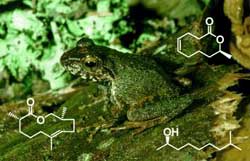A Hint of Frog in the Air

Amphibians are at home in water, but can they also sense volatile compounds in the air? “Indeed they can,” reports Stefan Schulz. Working with colleague Miguel Vences and Ph.D. students Dennis Poth and Katharina Wollenberg at the University of Brunswick, he has found volatile pheromones in frogs from Madagascar. In the journal Angewandte Chemie, the scientists have now introduced various natural compounds that the frogs apparently use for communication.
“Anuran amphibians communicate primarily by means of acoustic, optical, and tactile signals,” explains Schulz. “In addition, they also seem to communicate through peptides and proteins that easily dissolve in water or on the water’s surface. There have recently been indications that frogs may also respond to volatile signal compounds.”
Schulz and his co-workers have now examined frogs from Madagascar (Mantellidae), a very species-rich family of frogs from the rainforests. The males of one subspecies, the Mantellinae, form large characteristic glands on the undersides of their rear shanks.
The function of these glands was not previously known, but they could be related to pheromonal communication. Schulz and his colleagues now report a surprising discovery: “The glands contain volatile, nonpeptidic compounds that act as pheromones and are structurally related to volatile insect secretions.”
In the glands of the frog Mantidactylus multiplicatus, the researchers found two volatile main components, and demonstrated that the frogs react to both substances. One of the components is an alcohol, the other a macrolide, a ring-shaped molecule with an intramolecular ester group.
It is related to phoracantholide J, a component of the defensive secretion of the Australian beetle Phoracantha synonyma. However, the spatial arrangement of the atoms is different: the frog macrolide is the mirror image of the beetle molecule. For identification purposes, Schulz’s team developed a new synthetic route for the production of phoracantholide J that delivers enantiomerically pure products, either only the original version or the mirror image. Their method is also less complicated than earlier approaches.
The researchers found similar macrolides in the glands of related frogs. For example, in the species Gephyromantis boulengeri, they discovered a previously unknown macrolide that they named gephyromantolid A. “In fact, volatile compounds are widespread among the Mantellinae, but occur in species-specific mixtures,” says Schulz. “The volatile compounds could play a previously underrated role in species recognition over short distances in these very species-rich communities.”
This could explain the extreme degree of species diversity of frogs in the tropical rainforest. With over 100 species per region in Madagascar, chemical recognition of species could help to avoid failed pairings that lead to nonviable offspring. Such macrolides could thus have a significant influence on the speciation and evolution of tropical amphibians.
About the Author
Dr. Stefan Schulz is Professor of Organic Chemistry at the Technische Universität Braunschweig, where he is Director of the Institute for Organic Chemistry. His research interests include the chemistry of signal substances, natural materials chemistry, and environmental chemistry. He is particularly interested in the pheromones of insects, arachnids, reptiles amphibians, and bacteria.
Author: Stefan Schulz, Technische Universität Braunschweig (Germany), http://aks7.org-chem.nat.tu-bs.de/HTML/Mitarbeiter/aksss.html
Title: Volatile Amphibian Pheromones: Macrolides of Mantellid Frogs From Madagascar
Angewandte Chemie International Edition, Permalink to the article: http://dx.doi.org/10.1002/anie.201106592
Media Contact
More Information:
http://pressroom.angewandte.orgAll latest news from the category: Life Sciences and Chemistry
Articles and reports from the Life Sciences and chemistry area deal with applied and basic research into modern biology, chemistry and human medicine.
Valuable information can be found on a range of life sciences fields including bacteriology, biochemistry, bionics, bioinformatics, biophysics, biotechnology, genetics, geobotany, human biology, marine biology, microbiology, molecular biology, cellular biology, zoology, bioinorganic chemistry, microchemistry and environmental chemistry.
Newest articles

High-energy-density aqueous battery based on halogen multi-electron transfer
Traditional non-aqueous lithium-ion batteries have a high energy density, but their safety is compromised due to the flammable organic electrolytes they utilize. Aqueous batteries use water as the solvent for…

First-ever combined heart pump and pig kidney transplant
…gives new hope to patient with terminal illness. Surgeons at NYU Langone Health performed the first-ever combined mechanical heart pump and gene-edited pig kidney transplant surgery in a 54-year-old woman…

Biophysics: Testing how well biomarkers work
LMU researchers have developed a method to determine how reliably target proteins can be labeled using super-resolution fluorescence microscopy. Modern microscopy techniques make it possible to examine the inner workings…





















